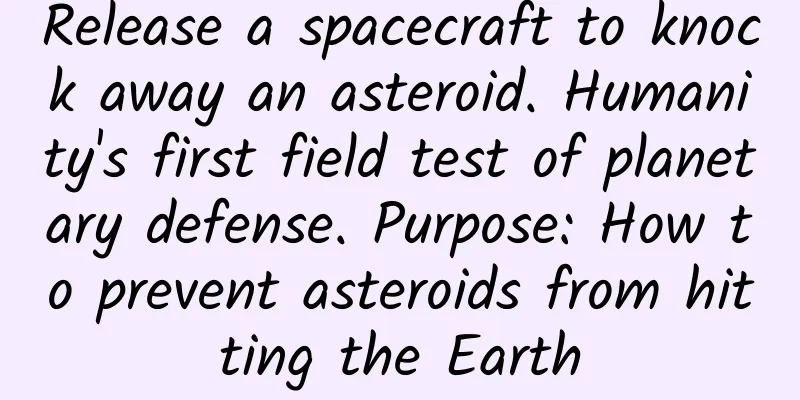Release a spacecraft to knock away an asteroid. Humanity's first field test of planetary defense. Purpose: How to prevent asteroids from hitting the Earth

|
Human beings have never done anything like this before: changing the direction of movement of natural celestial bodies. The first attempt was probably on September 26th. According to the NASA website, NASA's mission is called the Double Asteroid Redirect Test (DART). In space 11 million kilometers away from the earth, a spacecraft the size of a vending machine directly hit an asteroid satellite with a diameter of about 160 meters at a speed of 6 kilometers per second! This upcoming "violent" action will be the first time in human history that a spacecraft has tested kinetic impact technology, using a spacecraft to deflect asteroids and conduct planetary defense to protect the Earth from asteroid impacts. There is a pair of twin stars colliding with the smaller one This is a celestial body composed of two asteroids. The larger one is called Didymos, with a diameter of 780 meters, and the smaller one is called Dimorphos, with a diameter of 160 meters. In late September, they were about 10 million kilometers away from the Earth. In terms of classification, Apollo-type asteroids and Amor-type asteroids, which are near-Earth objects, are asteroids that pose a potential threat to the Earth. Dimorphos is a satellite that orbits Didymos, forming a binary asteroid system about 1,200 meters apart, and the entire binary asteroid system orbits the Sun together. The one NASA is going to hit this time is a smaller one, Dimorphos. Didymos was discovered in 1996 by the Kitt Peak National Observatory in the United States during a space surveillance program. In 2003, it was discovered that it had a companion star with a diameter of about 160 meters. Because it is a binary star, it was named Didymos, which is a Greek word meaning "twins." Impact 24,000 km/h The DART spacecraft was launched from Vandenberg Air Force Base in California on the evening of November 23, 2021, aboard SpaceX's Falcon 9. At that time, NASA Administrator Bill Nelson said: "We hope to see if we can slightly change the orbit of an asteroid by hitting it. If this is successful, then we have a direction for the future." DART is scheduled to hit Dimorphos on September 26 this year at a speed of more than 24,000 kilometers per hour. Hit it with a "slight miss" Let it be "a thousand miles away" The impact is not Superman flying into space to stop the asteroid from hitting the Earth, nor is it using a nuclear weapon to blow the asteroid to pieces. There is no exciting scene like that. DART's purpose is to deflect an asteroid using a technique called a kinetic impactor. NASA hopes the collision will nudge Dimorphos into a closer orbit to Didymos, shaving a few minutes off its nearly 12-hour orbit. If an asteroid threatens the Earth in the future, a spacecraft hitting it at an extremely high speed may be able to change its direction of motion and prevent it from flying towards the Earth. In other words, changing the trajectory of an asteroid on a microscopic scale can also deviate greatly on a macroscopic scale, reducing the chance of collision, and making it "miss by a hair's breadth" and "go a thousand miles off the mark." What happens if you hit it? I don't know if it's a big rock or a pile of rubble. What will happen if it hits? It is impossible to predict in advance. New simulations and laboratory experiments suggest that the mission's success depends on whether Dimorphos is a solid rock or a loose pile of rubble. The answer will be revealed in the craters and ejecta created by the impact, which may determine how difficult it was to hit the asteroid. "If it's a solid rock and we have a solid spacecraft, we're essentially playing a big game of billiards in space... and you can basically solve it as a simple physics equation," said Kristina Thomas, a planetary scientist at Northern Arizona University and leader of the DART mission's observation team. If the target is composed of thousands of rocks, predicting the consequences of hitting it is much more difficult than predicting the consequences of hitting a solid boulder. If the impact had been on a fragile rubble pile, a crater would have formed in a matter of hours, a process that could take months or even years to model, said Sabina Raducan, a planetary scientist at the University of Bern in Switzerland. Many eyes staring Record the impact and capture the details On the 11th, DART deployed a toaster-sized cube satellite LICIACube, which will use two optical cameras to record the impact process and results on September 26. "LICIACube will be released from a dispenser on one of DART's external panels and will be guided (braked and rotated) to start its autonomous journey towards Dimophos," said astronomer Elena Mazzotta Epifani of Italy's National Institute for Astrophysics. Elena said LICIACube will point its camera toward the asteroid system and DART to take some pictures. When the spacecraft hits the asteroid, LICIACube will observe the effects of the collision from a safe distance of 1,000 kilometers. Meanwhile, the James Webb and Hubble Space Telescopes and four ground-based observatories will take turns monitoring. Experts say that if Dimophos is a fragile rubble pile, telescopes should be able to capture its image within hours after the impact. The European Space Agency's Hera spacecraft, launched in October 2024, will also arrive to meet Dimorphos and conduct a close-up analysis of the impact, obtain details such as the internal structure and mass of the asteroid satellite Dimorphos, and observe the size of the crater produced after the impact. Will a planet hit the earth sooner or later? Asteroid impacts have been a hot topic for many years. Research suggests that extinction events in Earth's history are related to asteroid impacts. It is a popular topic in science fiction and a major topic in space exploration. NASA has conducted simulation experiments. The movie "Deep Impact" (also translated as "Deep Impact") released in 1998 tells a story like this: a comet hits the earth, and humans send the "Messiah" spacecraft to nuclear explode the comet. In the end, the "Messiah" also smashed the largest piece of comet debris and saved mankind. At present, the scientific community has not found any asteroids that will threaten the Earth, but they are sure that it is only a matter of time. As long as the time span is long enough, the impact on the Earth will happen sooner or later. "We're fighting back for our dinosaur friends," Adams said. "We are trying to learn how to defend against threats," said NASA chief scientist Alex Zurbuchen. The scientific community has identified 27,000 near-Earth asteroids, 10,000 of which are larger than 140 meters in diameter. NASA estimates that an asteroid larger than 140 meters in diameter will cause significant damage if it hits the Earth. 65 million years ago, an asteroid with a diameter of more than 140 meters collided with the Earth, causing the destruction of 2/3 of life on Earth and ending the dinosaur age. On June 30, 1908, the eastern part of Siberia was hit by an asteroid with a diameter of 50-80 meters, flattening 80 million trees and destroying more than 2,000 square kilometers of forest. In 2016, NASA established the Planetary Defense Coordination Office, whose sole mission is to prepare for this small but devastating possibility. Scientists estimate that a near-Earth object impact with global ecological effects occurs about once every 500,000 years. Reporter Liu Yimei comprehensive report |
<<: [Long Man] The well-tempered "special forces": I can defeat the virus!
>>: Why do flying insects always haunt the kitchen and bathroom? The reason behind this is…
Recommend
Launching a special health code for the elderly: Ministry of Industry and Information Technology requires WeChat, Alipay and other payment services to be adapted for the elderly
[[375494]] As the elderly population in my countr...
Computers can't understand the human series in "The Three-Body Problem"? No problem, take a look at this first!
Friends who have read "The Three-Body Proble...
In 5 months, DAU increased 9 times and exceeded 20 million daily active users. What did Huoshan Video do?
Today, taking Volcano as an example, let’s take a...
Tesla refuses to deliver Model 3 to Pinduoduo group-buying owners, saying it does not comply with delivery policy
On the afternoon of August 14, Sina Technology ex...
Have a happy winter vacation, stay safe! @Every parent and child, please check the winter vacation safety tips
As the Spring Festival approaches, many children ...
Unlock advanced methods of operating WeChat public accounts!
In addition to the conventional gameplay, what el...
[2014 WOT Shenzhen Station Lecturer Interview] Xie Zhen: Resource management makes the game more brilliant
From November 21 to 22, 2014, the 2014 WOT Global...
4 tips for user growth!
To achieve sustained growth, people must be the f...
【Practical】A complete collection of commonly used auxiliary tools for APP promotion!
Some people say that App promotion is hard work. ...
The Mystery of the Pleiades Star Cluster: The Pleiades Nebula
Author | Wang Siliang Review | Zheng Chengzhuo Ed...
The great American developer teaches you three tricks to get into the App Store recommended catalog!
Introduction: Robleh Jama is an experienced appli...
A 16-year-old girl got pregnant and was infected with AIDS. Can the disease be seen from the outside? What is the only way to find out the infection?
Xiaoying, 16, got pregnant unexpectedly right aft...
Chengdu Tea Selection Studio, a great place to drink and taste tea
Appointment arrangements for Chengdu Tea Tasting ...
Where did the ancient forests that did not turn into coal eventually go?
In the heavy rain, a group of Placerias slowly wa...
How much do you know about Facebook operation skills?
Everyone knows how to use Facebook to attract tra...









